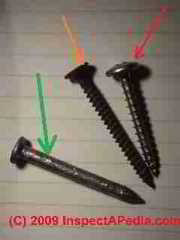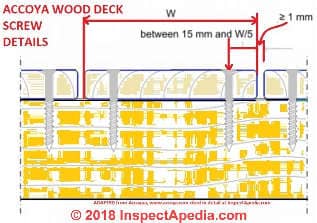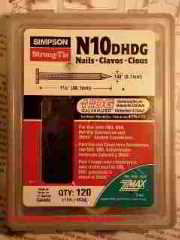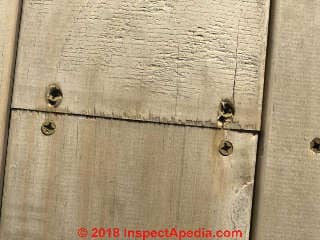 Wood Framing Fastener FAQs
Wood Framing Fastener FAQs
Q&A on Stud, Joist, Porch, Deck Board Screws & Nails
- POST a QUESTION or COMMENT about structural fasteners, nails, bolts, or hidden fasteners for wood framing of buildings, decks & porches
FAQs about the choices of deck structural & flooring fasteners.
This article series describes the selection of the right types of construction screws, nails, bolts to use when building a deck, railing, or exterior stair.
These articles also explain critical safe-construction details for decks and porches, including avoiding deck or porch collapse and unsafe deck stairs and railings.
InspectAPedia tolerates no conflicts of interest. We have no relationship with advertisers, products, or services discussed at this website.
Q&A on Selecting Proper Deck & Porch Screws, Nails, Lags, Bolts
 These questions and answers were posted originally at FRAMING FASTENERS, NAILS, SCREWS so you'll want to review that information too.
These questions and answers were posted originally at FRAMING FASTENERS, NAILS, SCREWS so you'll want to review that information too.
On 2019-01-15 by (mod) - proper deck board screw location & type to avoid splitting
Sharon
If you can find (and post a photo of ) the box in which the deck screws were sold we can confirm their composition, coating, and suitability for deck installation.
Illustration adapted from Accoya cited in detail below.
[Click to enlarge any image]
Depending on where you live and also on the properties of the wood decking, coated deck screws such as those under the ZMAX brand are suitable and durable.
In some climates where there are more corrosive forces at work, such as along a sea coast, stainless screws would be preferred.
Screws used in conventional SYP treated lumber should either be stainless steel or should use a coating rated for that application.
While I like stainless screws (that cost a bit more), some owners prefer coated deck screws like the ones your contractor used, because they are colour matched closer to the wood while the stainless screws are forever shiny and more noticeable.
I agree that in your photo one of the screws is in a split and all four are a bit close to the board end.
Keep in mind that at the board end putting screws within an inch or less of the end is pretty much necessary as the width of a typical underlying 2x joist is just 1 1/2" and the screw has to hit the joist.
Here is what Accoya says about fastening decking:
As Accoya® wood decking is slightly acidic, like most durable woods, it is recommended to use A2 (general applications) or A4 (for seacoast exposures) stainless steel.
To ensure a durable and lasting fixation, the boards should be fixed with at least 50 mm clearance to the end of the board (use self-drilling screws or pre drill the hole to 1 mm less than the shank diameter).
Due to its dimensional stability, Accoya® deckboards will not shrink and swell and cause damage around fixings, or splinter so it can be classed as barefoot friendly.
50mm from the board end? Really? The 50mm end distance cited by Accoya is just under 2 inches - there is no way one can send a screw through a deck board into an individual deck joist from two inches away.
You'll have to ask the company what they think the deck builder should do if two Accoya wood deck boards have to meet over a single joist.
If I found a problem with splitting deck boards screwed near the board end I would probably pre-drill those specific screw holes to reduce that problem. In your photo you'll notice that two screws are shot straight down and end flush with the board top and the other two were sent on an angle, ostensibly to catch the joist below.
Those more-deeply-driven deck screw heads close to the board end are more-likely to cause splitting.
For the worst of those incidents I might back offending screw and remove it (the upper right screw n your photo and I might shoot a new screw in a bit back from the board edge and a bit closer to board center to avoid that split. However the irregular placement of screws is less beautiful.
Bottom line: I would not be excited about one or two or even a few screws that looked bad on the new deck, BUT if I saw many splilt board ends and particularly if the board ends began to lose their connection to the joist below, I'd want to repair those, possibly by having to add some blocking below to catch new screws.
Contact Accoya
- Accoya, Brettenham House, 19 Lancaster Place, London WC2E 7EN United Kingdom T: +44 (0)20 7421 4300 Website: www.accoya.com
What is Accoya wood?
From the same source:
In contrast, Accoya® uses a fast growing temperate, softwood species, Radiata Pine, from sustainably managed forests (FSC® certified), and due to the high yield and long life span is more efficient at locking away CO2 for longer. - retrieved 2019/01/15 original source: www.accoya.com/blog/what-is-the-best-timber-to-use-for-decking/
Summary of Deck Screw Types & Coatings
For a nice online article describing the types of coatings used on deck screws - there are at least 8 options
- Stainless steel deck screws
In addition to stainless steel screws (itself sold in more than one grade) here are at least 7 kinds of coatings used on deck screws listed below. - Electro-plated clear zinc coating on steel screws
- Mechanically-galvanized zinc coated steel screws
- Resin & polymer coated steel screws
- Silicone-bronze coated steel screws
- Yellow zinc coated steel screws
- Zinc double-coated + 2 clear coat layers on steel screws
- Zinc chromate and polymer coated steel screws
This article from Wood Magazine is helpful: www.woodmagazine.com/materials-guide/fasteners/drive-screws-that-dont-corrode
Finally: when I last installed deck boards on a lakefront deck in northern Minnesota in 2018 we used screws on which the underside of the head was serrated and whose point was self-drilling with a notch or flute.
I found those screws minimized splits near board ends.
On 2019-01-15 by sharon Z - splits at the ends of our Accoua wood deck
Our builder recently installed an Accoya-wood deck using screws. In addition to the aesthetically unpleasing look of the exposed screws, my concerns are
1) he used 'exterior grade screws' versus stainless steel as recommended by Accoya and
2) close proximity of screws to edges of boards where two boards meets is an opportunity for wood splitting (as already seen here).
Comments?
On 2017-09-01 by (mod) - unsafe decks and porches if improper or failing fasteners
Watch out: If nails are coming out the porch may also be unsafe. Perhaps adding the proper type and size construction screws can salvage the situation at little expense.
On 2017-08-31 by Ms Jackson.
I don't believe my porch was built correctly the nails are coming out the wood was spilting wheen the first started I'm very disappointed.
On 2017-03-31 by (mod) - use the right fasteners for framing connectors
 Galvanized, nails, sold in the correct length and size for used with metal framing connectors, of course widely available and are normally package then displayed right next to the location where the framing connectors are sold.
Galvanized, nails, sold in the correct length and size for used with metal framing connectors, of course widely available and are normally package then displayed right next to the location where the framing connectors are sold.
That's what you should use, that is you should use fasteners that the manufacturer approved for use with the framing connector
See details at FRAMING CONNECTORS & JOIST HANGERS
and at CONNECTORS, FASTENERS, TIES
Watch out: do NOT use drywall screws (not a structural fastener) and do n ot use roofing nails as shown in the framing connector photo here.
Your structure may collapse, injuring people or worse.
On 2017-03-31 by uruiamme
The most common fasteners I see in structural hangars is of course the drywall screw, followed by the deck screw. I would emphasize that deck screws, while great for fastening deck boards, are nearly worthless for structural purposes.
The only good thing I see about them in the construction phase of the deck is to supplement the end-nail of a joist which is fastened to a cap board.
 If a deck is made so that the joists rest on a girder, and then they are capped by a second board that has little structural intent, then the joists shouldn't be simply end-nailed. Screws in the end are less likely to cause the cap to back out.
If a deck is made so that the joists rest on a girder, and then they are capped by a second board that has little structural intent, then the joists shouldn't be simply end-nailed. Screws in the end are less likely to cause the cap to back out.
This type of deck construction is needed in a number of situations... but the most notorious is where a deck is made with curves or obtuse angles, the girder is hidden, and the joists cantilever over for a few inches or feet. Otherwise be careful of deck screws being used in the framing stage.
Furthermore, the USP/Simpson tables are generally specifying common nails. Most people use sinkers for a lot of things and do not know the difference. If sinkers were more available in galvanized, you'd see them on decks.
Many stores do not understand how to stock both the hangars and the fasteners, and so the DIYer has almost no chance of actually getting it right.
Most contractors, without the help of an inspector, will get it wrong. I wish the manufacturers would print a manual and afix it to every 10th one to show my subcontractors what to do and which nails are to be used.
The hangars need to have these numbers on them, too. If it's not a hurricane tie, most people get really confused.
And lastly, nails should be rated and labeled better.
Some of the high-dollar ones (like the Simpson you show) have "N10" or "10" on them for identity, and the structural screws definitely do. But I wonder if the off-brand "N10" perform to the specs intended by USP/Simpson... they are 1/3 the cost of the ones shown.
On 2015-11-26 by (mod) - Both ribbed nails and glue-coated nails have withdrawal resistance
Interesting question; I can't research an answer without knowing the application - what is being nailed to what. Both ribbed nails and glue-coated nails have withdrawal resistance, as you clearly understand. The former relies on mechanical resistance and the latter to a heat-from-driving-nail activated glue to secure the nail in place.
Nails structural strength in normal applications is concerned with shear strength not withdrawal strength. If we know more about the application or if you could contact the engineer or architect who drew up the plans perhaps we'd both learn an interesting answer.
There are special applications in which withdrawal resistance becomes important such as in locations subject to vibration, fastening flooring, and other uses.
The withdrawal resistance of adhesive-coated nails was described as having 251 pounds of withdrawl resistance citing an old 1904 article in Ohio Architect and Builder, "Device for Measuring Force Required to Drive Nails", p. 38,
Research on Screw & Nail Withdrawl Strengths & Failures
- Aytekin, Alper. "Determination of screw and nail withdrawal resistance of some important wood species." International journal of molecular sciences 9, no. 4 (2008): 626-637.
- Smith, Ian, Luke RJ Whale, Colin Anderson, Barry O. Hilson, and Peter D. Rodd. "Design properties of laterally loaded nailed or bolted wood joints."Canadian Journal of Civil Engineering 15, no. 4 (1988): 633-643.
- Mclain, Thomas E. "Design axial withdrawal strength from wood: II. Plain-shank common wire nails." Forest products journal 47, no. 6 (1997): 103.
- Rammer, Douglas R., Steve G. Winistorfer, and Donald A. Bender. "Withdrawal strength of threaded nails." Journal of structural engineering 127, no. 4 (2001): 442-449.
- Skulteti, M. J., D. A. Bender, S. G. Winistorfer, and D. G. Pollock. "Withdrawal strength of ring-shank nails embedded in southern pine lumber." Transactions of the ASAE-American Society of Agricultural Engineers 40, no. 2 (1997): 451-456.
- Herzog, Benjamin, and B. Yeh. "Nail withdrawal and pull-through strength of structural-use panels." equilibrium 1100 (2006): 6-10.
- Theilen, Ross Dean. "LATERAL RESISTANCE OF RING-SHANK NAIL CONNECTIONS." PhD diss., Texas A&M University, 1996.
From a review of some of these articles my OPINION (meaning more research is to be done) it may be that ribbed nails perform better (with respect to withdrawal resistance) than adhesive-coated nails when nailing softwoods such as SYP while adhesive coated nails may perform as well or better in flooring and hardwood applications where forces (such as moisture-induced buckling) tend to lift or withdraw nails rather than subject them to shear.
On 2015-11-25 by ken
I have a situation where the plan calls out that ribbed structural nails are to be used and not glue coated structural nails.
I was just wondering why the notes would call this out. I was also wondering if they were to glue coat a ribbed structural nail wouldn’t that yield a stronger connection?
...
Continue reading at DECK FASTENER CHOICES or select a topic from the closely-related articles below, or see the complete ARTICLE INDEX.
Or see these
Recommended Articles
- CONNECTORS, FASTENERS, TIES
- FRAMING CONNECTORS & JOIST HANGERS
- DECK CONSTRUCTION BEST PRACTICES - home
- DECK DESIGN & BUILD - home
Suggested citation for this web page
FRAMING FASTENERS, NAILS, SCREWS FAQs at InspectApedia.com - online encyclopedia of building & environmental inspection, testing, diagnosis, repair, & problem prevention advice.
Or see this
INDEX to RELATED ARTICLES: ARTICLE INDEX to BUILDING DECKS & PORCHES
Or use the SEARCH BOX found below to Ask a Question or Search InspectApedia
Or see
INDEX to RELATED ARTICLES: ARTICLE INDEX to BUILDING STRUCTURES
Or use the SEARCH BOX found below to Ask a Question or Search InspectApedia
Ask a Question or Search InspectApedia
Try the search box just below, or if you prefer, post a question or comment in the Comments box below and we will respond promptly.
Search the InspectApedia website
Note: appearance of your Comment below may be delayed: if your comment contains an image, photograph, web link, or text that looks to the software as if it might be a web link, your posting will appear after it has been approved by a moderator. Apologies for the delay.
Only one image can be added per comment but you can post as many comments, and therefore images, as you like.
You will not receive a notification when a response to your question has been posted.
Please bookmark this page to make it easy for you to check back for our response.
Our Comment Box is provided by Countable Web Productions countable.ca
Citations & References
In addition to any citations in the article above, a full list is available on request.
- In addition to citations & references found in this article, see the research citations given at the end of the related articles found at our suggested
CONTINUE READING or RECOMMENDED ARTICLES.
- Carson, Dunlop & Associates Ltd., 120 Carlton Street Suite 407, Toronto ON M5A 4K2. Tel: (416) 964-9415 1-800-268-7070 Email: info@carsondunlop.com. Alan Carson is a past president of ASHI, the American Society of Home Inspectors.
Thanks to Alan Carson and Bob Dunlop, for permission for InspectAPedia to use text excerpts from The HOME REFERENCE BOOK - the Encyclopedia of Homes and to use illustrations from The ILLUSTRATED HOME .
Carson Dunlop Associates provides extensive home inspection education and report writing material. In gratitude we provide links to tsome Carson Dunlop Associates products and services.


